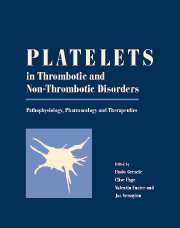Book contents
- Frontmatter
- Contents
- List of contributors
- Editors' preface
- PART I PHYSIOLOGY
- PART II METHODOLOGY
- PART III PATHOLOGY
- PART IV PHARMOLOGY
- PART V THERAPY
- 68 Design of trials to evaluate antiplatelet agents
- 69 Antiplatelet therapy in cardiology
- 70 Antiplatelet therapies in neurology
- 71 Antiplatelet treatment in peripheral vascular disease
- Afterword: Platelets: a personal story
- Index
- Plate section
69 - Antiplatelet therapy in cardiology
from PART V - THERAPY
Published online by Cambridge University Press: 10 May 2010
- Frontmatter
- Contents
- List of contributors
- Editors' preface
- PART I PHYSIOLOGY
- PART II METHODOLOGY
- PART III PATHOLOGY
- PART IV PHARMOLOGY
- PART V THERAPY
- 68 Design of trials to evaluate antiplatelet agents
- 69 Antiplatelet therapy in cardiology
- 70 Antiplatelet therapies in neurology
- 71 Antiplatelet treatment in peripheral vascular disease
- Afterword: Platelets: a personal story
- Index
- Plate section
Summary
Introduction
Antiplatelet therapy has revolutionized the care of patients with cardiovascular disease. It is frequently utilized in patients with heart failure, valvular heart disease and rhythm disturbances. However, its greatest impact has been in the prevention and treatment of coronary artery disease (CAD). CAD is presently the leading cause of death, and fifth leading cause of disability worldwide and is projected to be the number one cause of death and disability in the world by the year 2020. Given its considerable contribution to the global burden of disease, and the substantial reductions antiplatelet therapy has made on its attendant morbidity and mortality, this chapter will focus on the role of antiplatelet therapy in CAD.
The platelet plays a pivotal role in the development and progression of stable CAD as well as in the pathogenesis of its unstable clinical presentations (i.e. unstable angina, non-ST elevation myocardial infarction (MI) and ST elevation MI). While the pathways of platelet activation are manifold, relatively few have been successfully exploited for the prevention and treatment of CAD (Fig. 69.1). This chapter will review the current evidence base for three types of antiplatelet agents: aspirin, adenosine diphosphate (ADP) receptor antagonists and platelet glycoprotein (GP) IIb/IIIa inhibitors. As detailed elsewhere in this book, aspirin inhibits platelet aggregation by interfering with the formation of cyclic prostanoids (thromboxane A2, prostacyclin and other prostaglandins), ticlopidine and clopidogrel do so by irreversible antagonism of ADP P2Y receptors, and GP IIb/IIIa inhibitors accomplish this via blockade of the integrin receptor αIIbβ3, the final common pathway of platelet aggregation.
- Type
- Chapter
- Information
- Platelets in Thrombotic and Non-Thrombotic DisordersPathophysiology, Pharmacology and Therapeutics, pp. 1013 - 1039Publisher: Cambridge University PressPrint publication year: 2002
- 1
- Cited by

